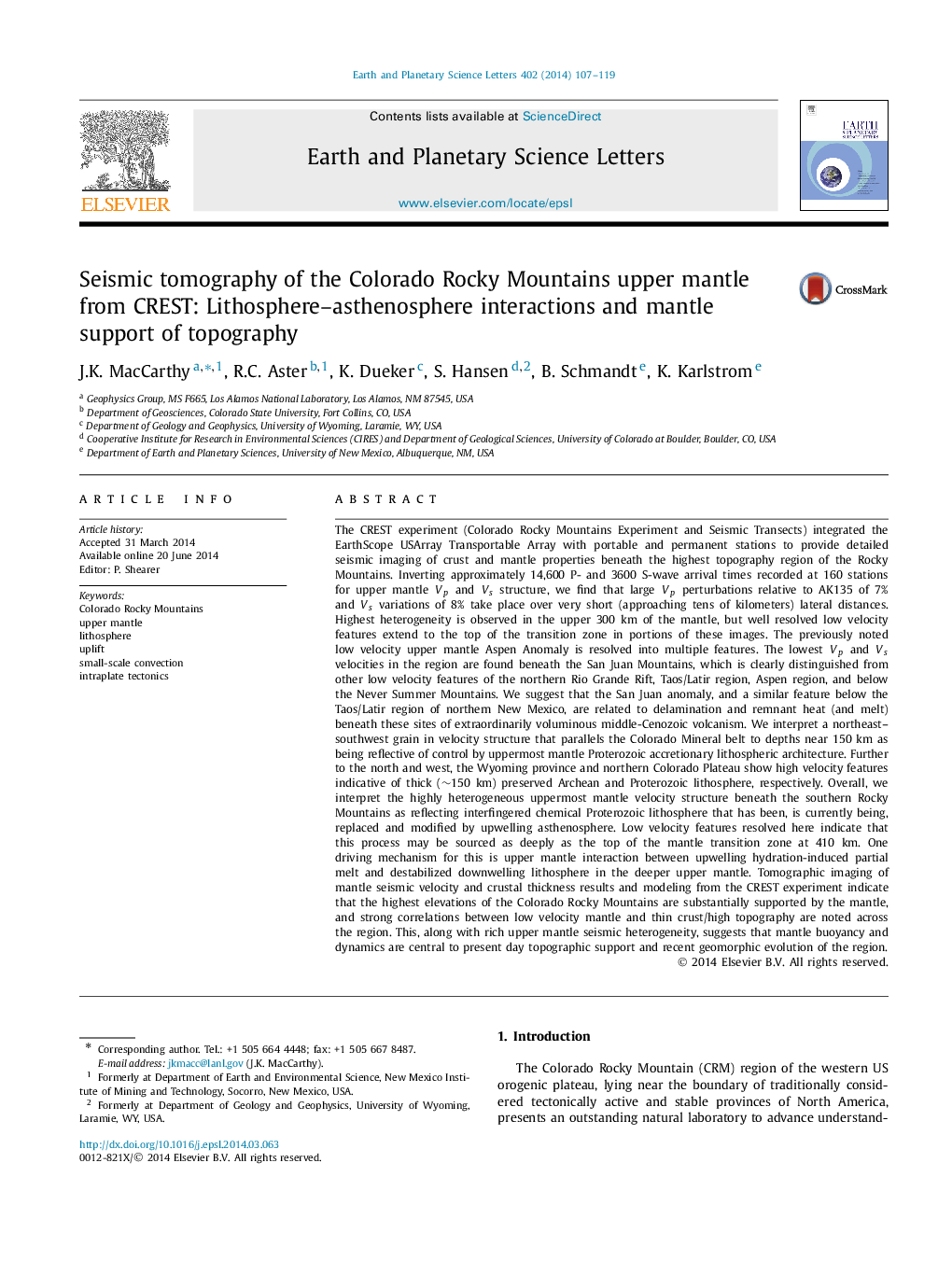| کد مقاله | کد نشریه | سال انتشار | مقاله انگلیسی | نسخه تمام متن |
|---|---|---|---|---|
| 4677000 | 1634754 | 2014 | 13 صفحه PDF | دانلود رایگان |

• We produce 3D dVpdVp, dVsdVs, and Vp/VsVp/Vs velocity models of the Southern Rocky Mountains.
• Large-amplitude low-velocity anomalies correlate with Oligocene volcanic centers.
• Geometry of anomalies suggest influence from Proterozoic lithospheric structure.
• Large implied lateral thermal and density gradients suggest small-scale convection.
• Low-velocity zones may extend as deeply as the top of the mantle transition zone.
The CREST experiment (Colorado Rocky Mountains Experiment and Seismic Transects) integrated the EarthScope USArray Transportable Array with portable and permanent stations to provide detailed seismic imaging of crust and mantle properties beneath the highest topography region of the Rocky Mountains. Inverting approximately 14,600 P- and 3600 S-wave arrival times recorded at 160 stations for upper mantle VpVp and VsVs structure, we find that large VpVp perturbations relative to AK135 of 7% and VsVs variations of 8% take place over very short (approaching tens of kilometers) lateral distances. Highest heterogeneity is observed in the upper 300 km of the mantle, but well resolved low velocity features extend to the top of the transition zone in portions of these images. The previously noted low velocity upper mantle Aspen Anomaly is resolved into multiple features. The lowest VpVp and VsVs velocities in the region are found beneath the San Juan Mountains, which is clearly distinguished from other low velocity features of the northern Rio Grande Rift, Taos/Latir region, Aspen region, and below the Never Summer Mountains. We suggest that the San Juan anomaly, and a similar feature below the Taos/Latir region of northern New Mexico, are related to delamination and remnant heat (and melt) beneath these sites of extraordinarily voluminous middle-Cenozoic volcanism. We interpret a northeast–southwest grain in velocity structure that parallels the Colorado Mineral belt to depths near 150 km as being reflective of control by uppermost mantle Proterozoic accretionary lithospheric architecture. Further to the north and west, the Wyoming province and northern Colorado Plateau show high velocity features indicative of thick (∼150 km) preserved Archean and Proterozoic lithosphere, respectively. Overall, we interpret the highly heterogeneous uppermost mantle velocity structure beneath the southern Rocky Mountains as reflecting interfingered chemical Proterozoic lithosphere that has been, is currently being, replaced and modified by upwelling asthenosphere. Low velocity features resolved here indicate that this process may be sourced as deeply as the top of the mantle transition zone at 410 km. One driving mechanism for this is upper mantle interaction between upwelling hydration-induced partial melt and destabilized downwelling lithosphere in the deeper upper mantle. Tomographic imaging of mantle seismic velocity and crustal thickness results and modeling from the CREST experiment indicate that the highest elevations of the Colorado Rocky Mountains are substantially supported by the mantle, and strong correlations between low velocity mantle and thin crust/high topography are noted across the region. This, along with rich upper mantle seismic heterogeneity, suggests that mantle buoyancy and dynamics are central to present day topographic support and recent geomorphic evolution of the region.
Journal: Earth and Planetary Science Letters - Volume 402, 15 September 2014, Pages 107–119